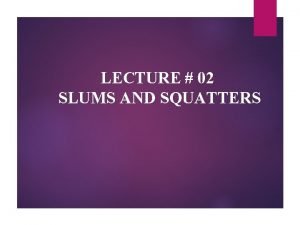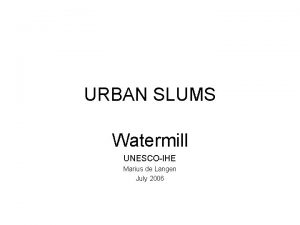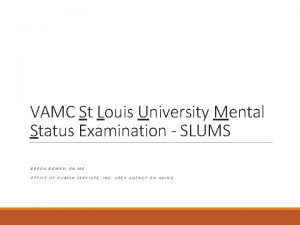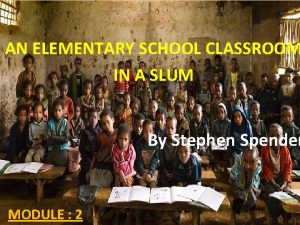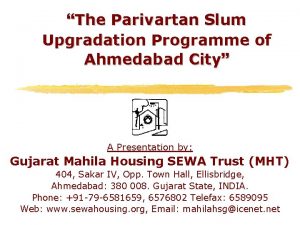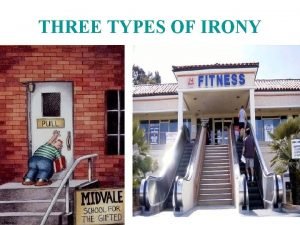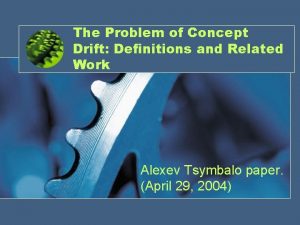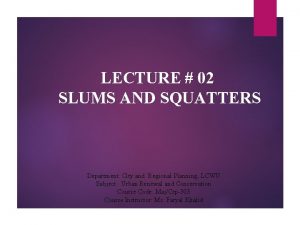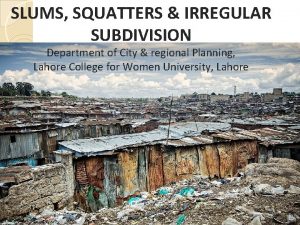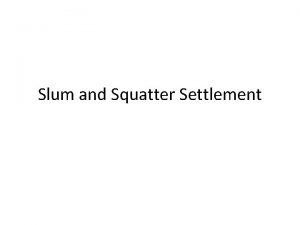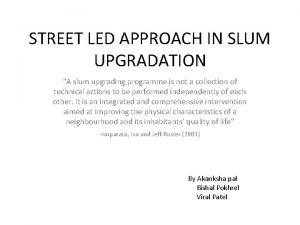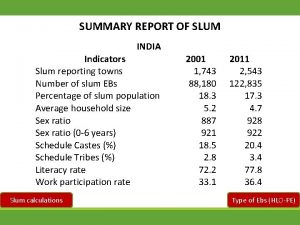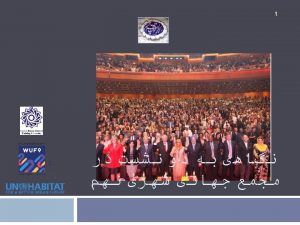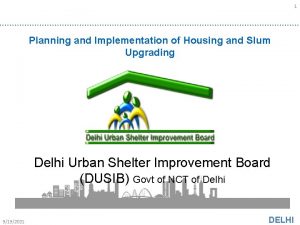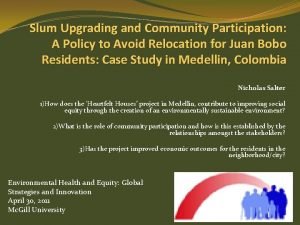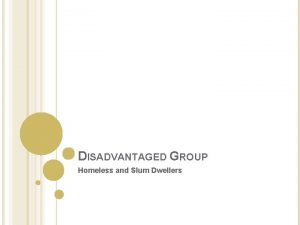LECTURE 02 SLUMS AND SQUATTERS DEFINITIONS Slum is


















- Slides: 18

LECTURE # 02 SLUMS AND SQUATTERS

DEFINITIONS Slum is defined as “A heavily populated urban area characterized by sub-standard housing. And squalor. ( UNHABITAT) A squatter settlement, on the other hand, is an area of poor quality housing built on illegally occupied land. Squatters settle on land especially public or unoccupied land without right or title. Slums refer to the environmental aspects of the area where a community resides, while squatters refer to the legality of the Land ownership and other infrastructure provision.

OTHER AFFILIATED TERM GHETTO The difference is that the majority of dwellers belongs to a certain racial, ethnic or religious group and is in minority as compared to overall population.

HOW SLUMS LOOK LIKE?

CHARACTERISTICS OF SLUMS The characteristics associated with slums vary from context to context. Still, they are usually characterized by: § Urban blight § High rates of poverty and unemployment § Breeding ground for social problem such as drug addiction, alcoholism, high rate of mental illness and suicide § High rate of diseases.

CHARACTERISTICS OF SLUMS § It is overcrowded by extremely high density of dwellings and population. § Dilapidated and poor quality housing structures. § It lacks basic services such as adequate access to safe water, paved walkways and sanitation § Insecure residential status. § Low socio economic status

GROWTH OF SLUMS According to UN-Habitat around 33% of the urban population in the developing world in 2012, or about 863 million people lived in slums. The proportion of urban population living in slums in 2012 was highest in Sub-Saharan Africa (62%) , followed by the Southern Asia (35%), South eastern Asia (28%), Western Asia (25%), Oceania (24%), Latin America and the Caribbean (24%), and north Africa (13%).

Cont. . 31. 6% of the world’s total population lives in slums. Percentage increases up to 43 percent for developing countries and becomes 78. 2% for the least developed countries. Total number of slum-dwellers in the world increases by about 36 percent during the 1990 s and in the next 30 years , it is expected to increase by 2 billion.

CAUSES OF SLUMS Rapid rural-to-urban migration Economic stagnation and depression Poverty Informal economy Natural disasters Politics

CAUSES OF SQUATTERS High cost of living Lack of proper housing. Social Marginalization. Inadequate formal land distribution

PROBLEMS ASSOCIATED WITH SLUMS Narrow alleys that do not allow vehicles like ambulances , fire brigades, trucks , SWM vehicles to pass. Heaps of garbage accumulates on streets without collection. Infrastructure facilities can not be improved due to haphazard settlements pattern.

POTENTIALS FOR SLUMS Improve the quality of life for poor people by providing access to clean water, improved sanitation, and waste management services; and supporting secure land tenure and affordable housing. Scale-up the capacity of local people and their institutions to engage with local authorities and other service providers for the sustainable provision of basic services. Support income-generation activities that enable households to secure funds for the improvement of physical facilities. Adoption of more pro-poor policies and practices for slum upgrading and land tenure at local and national levels.

POTENTIALS FOR SQUATTER SETTLEMENTS SITE AND SERVICE SCHEMES These give people the chance to rent or buy a piece of land. The land is connected to the city by transport links and has access to essential services (e. g. water). People build their own homes using money from a low-interest loan. SELF-HELP SCHEMES These give people the tools and training to improve their homes. Low-interest loans may be used to help people fund these changes. People may be given legal ownership of the land.

Cont. . RURAL INVESTMENT Improving the quality of life and creating greater opportunities in rural areas may prevent people from migrating to urban areas. Investment in rural areas may therefore help to improve conditions in the city as well.

SLUMS AND SQUATTER IDENTIFICATION There is no universal model of a slum and squatter in a physical sense that would allow the development of a standard method for all slum identification and mapping. The diversity of slum and squatter conditions is such that even within one city many different manifestations of slums may be found, each of which may require specific methodological adjustments for identification and mapping.

Cont. . The globally used method for the identification and delineation of slum and squatters areas based on high resolution remote sensing images and supplementary data sets, e. g. census and related GIS data on infrastructure and services. This allows the formulation of a global strategy to collect sufficient and reliable information at the sub-city level and to link that to information at the city level.

KATCHI ABADIS IN PAKISTAN Squatter settlements are meant by the word Katchi Abadis in the context of Pakistan. All settlements that were on illegal lands either of government or private sector, comprising a minimum number of 30 dwelling unit as on or before 23 March, 1985 were declared as Katchi Abadis by Junejo Government. According to World Bank report, 13. 1% or one in eight people living in urban areas live below the national poverty line.

KATCHI ABADIS IN PAKISTAN Ownership rights were transferred to the dwellers of Katchi Abadis with the binding that they could not sell their property before 5 years. Katchi Abadis on private lands were deleted in the documents as Katchi Abadis Transferred Katchi Abadis were further mutated by the Revenue Department.
 Difference between slum and squatter
Difference between slum and squatter Problem of slums
Problem of slums Vamc slums examination
Vamc slums examination Introduction of an elementary school classroom in a slum
Introduction of an elementary school classroom in a slum 01:640:244 lecture notes - lecture 15: plat, idah, farad
01:640:244 lecture notes - lecture 15: plat, idah, farad Cramped holes figure of speech
Cramped holes figure of speech Martin luther king jr timeline of events
Martin luther king jr timeline of events What property did meherjan lose due to river erosion
What property did meherjan lose due to river erosion Project on elementary school classroom in a slum
Project on elementary school classroom in a slum Meherjan
Meherjan Parivartan slum ahmedabad
Parivartan slum ahmedabad Meherjan lives in a slum
Meherjan lives in a slum Gergo dello slum
Gergo dello slum Slum tourism definition
Slum tourism definition The paper seeming boy with red eyes mean the boy is
The paper seeming boy with red eyes mean the boy is Meherjan lives in a slum
Meherjan lives in a slum What are different types of irony
What are different types of irony The problem of concept drift: definitions and related work
The problem of concept drift: definitions and related work Carburizing flame definition
Carburizing flame definition
